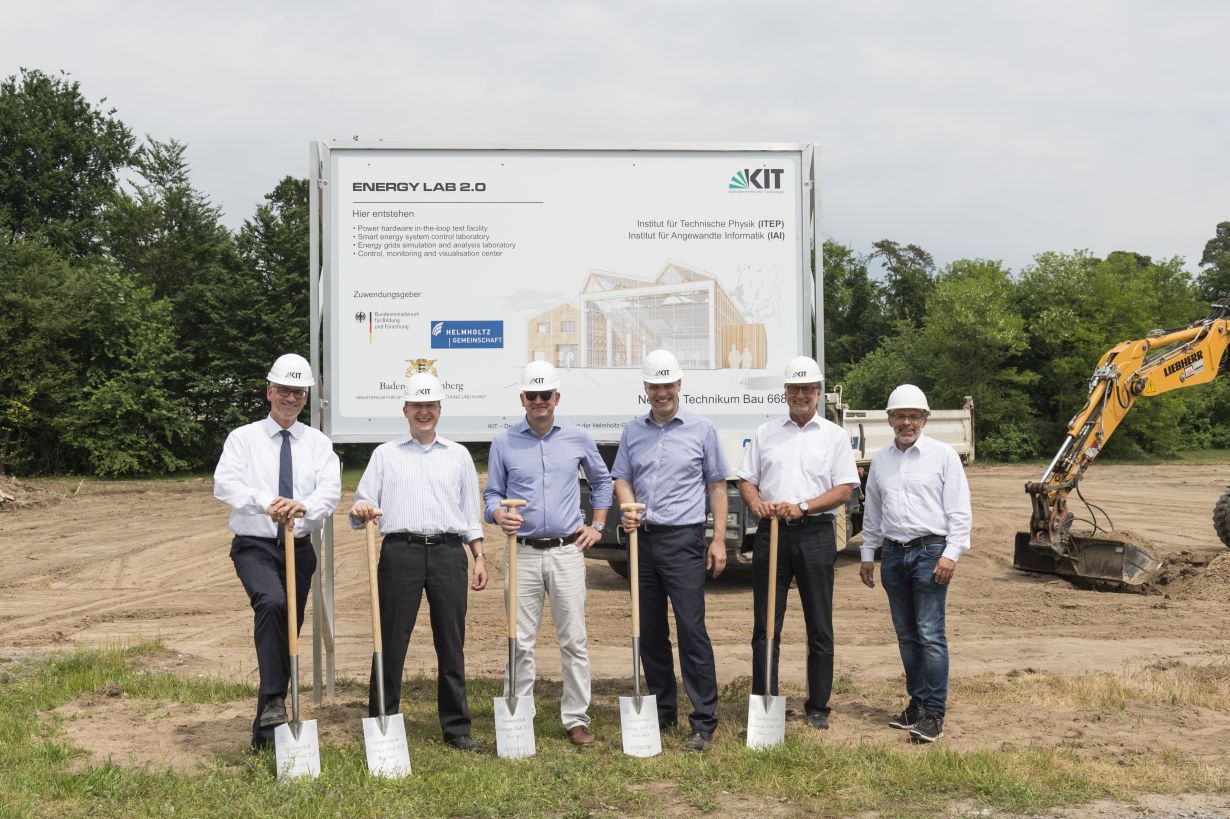The energy of the future will be based on the flexible coupling of electric current, heat and cold, gas and fuels, forming an intelligent overall energy system whose components are interlinked by IT technology. The required technologies will be developed by KIT and its partners in the Energy Lab 2.0 project funded by the German Federal Government and the State of Baden-Württemberg with around EUR 22 million. Now, ground-breaking took place for the construction of the first building and lab complex of this project which is supposed to span 20 years.
“KIT makes major contributions to cope with the challenges our society is facing in the fields of energy, mobility, and information,” said Professor Holger Hanselka, President of KIT and at the same time Research Field Coordinator Energy of the Helmholtz Association. “The answers to questions about the future can only be found at the interfaces between disciplines. At exactly this point – the interface between energy and information – KIT steps in with Energy Lab 2.0.”
“The great challenge of the energy turnaround is to integrate fluctuating energy sources in such a way that energy remains affordable and reliable,” underlines Professor Joachim Knebel, head of the “Mechanical and Electrical Engineering” division at KIT. “Energy Lab 2.0, in its function as a ‘real-life lab’ and simulation platform, allows us to test various approaches for integrating the most diverse technologies into the energy system.” For this purpose, larger test facilities for the generation of renewable electric power, for its storage and conversion into gas, fuel and heat, and for the re-conversion of chemical energy carriers into electricity will be coupled with each other for the first time. Thus, different designs of a cellular, flexible, and intelligent overall power supply system can be derived, examined, and tested thoroughly.und intelligentes Gesamtsystem zur Energieversorgung ableiten und umfassend untersuchen.
Besides coupling electrical, thermal, and chemical energy flows and storage systems, the focus lies on devising novel information and communications technology for controlling coupled energy grids. The “Smart Energy System Simulation and Control Center” (SEnSSiCC), to which the new building is dedicated, will couple these systems to form an “intelligent” overall system. The new project will have 800 square meters of experiment and lab area at its disposal.
The SEnSSiCC serves as a platform to develop control engineering concepts for local smart-energy systems, allowing us to conduct lab-scale experiments that involve all relevant components. Both standardized and particularly critical operating conditions can be studied and trainings can be held. Another part of the building will host a lab where electric equipment with a high power consumption can be tested under realistic, but safe conditions in real time. The SEnSSiCC also allows to explore and simulate multi-scale energy systems that directly combine different energy carriers. The SEnSSiCC consists of four subprojects:
The PHIL system (Power Hardware in the Loop) is intended for testing single real electric components with a power of up to 1MVA, such as a transformers, inverters, or current limiters in a (simulated) complex electric grid, including evaluation of its retroactive effects. Moreover, a real-life generator, such as a solar cell module, can load the virtual battery of an electric car or supply a simulated (small) residential area with electricity.
In the “Smart Energy System Control Laboratory”, energy grids in the power range of 100 to 200 kVA will be tested by bringing them close to their stability limits. The facility includes real machines, devices, and systems that are required to couple power grids with heat distribution systems, such as heat pumps, electric heating units, gas-operated cogeneration facilities, up to DC motors and intelligent household devices.
The focus of the LCC (Control, Monitoring and Visualization Center) subproject, finally, lies on creating the control and monitoring center for the basic monitoring and operational support of the facilities operated in Energy Lab 2.0 and on investigating novel planning and optimization tools for the operation and planning of overall “Smart Grid” solutions.
In the “Energy Grids Simulation and Analysis Laboratory” subproject, the scientists develop executable software models for power engineering facilities and complex smart grids.
The building is financed by institutional funding from the Federal Ministry of Education and Research, amounting to EUR 1.4 million, and the Baden-Württemberg Ministry of Science, Research, and the Arts with EUR 0.6 million within the framework of the Energy Lab 2.0 project. The total investment sum amounts to EUR 22 million, of which EUR 16.75 million will be invested at KIT. The Helmholtz Association contributes a total of EUR 15 million to the Energy Lab 2.0 project. The State of Baden-Württemberg funds Energy Lab 2.0 with EUR 3 Million. The BMBF (Federal Ministry of Education and Research) supports the project with an additional amount of EUR 2.5 million, the BMWi (Federal Ministry for Economic Affairs and Energy) with EUR 1.5 million. The operation of Energy Lab 2.0 is planned for a period of 20 years.
Read more about Energy Lab 2.0:
More about the KIT Energy Center: http://www.energie.kit.edu
Being “The University in the Helmholtz Association”, KIT creates and imparts knowledge for the society and the environment. It is the objective to make significant contributions to the global challenges in the fields of energy, mobility, and information. For this, about 10,000 employees cooperate in a broad range of disciplines in natural sciences, engineering sciences, economics, and the humanities and social sciences. KIT prepares its 22,800 students for responsible tasks in society, industry, and science by offering research-based study programs. Innovation efforts at KIT build a bridge between important scientific findings and their application for the benefit of society, economic prosperity, and the preservation of our natural basis of life. KIT is one of the German universities of excellence.

